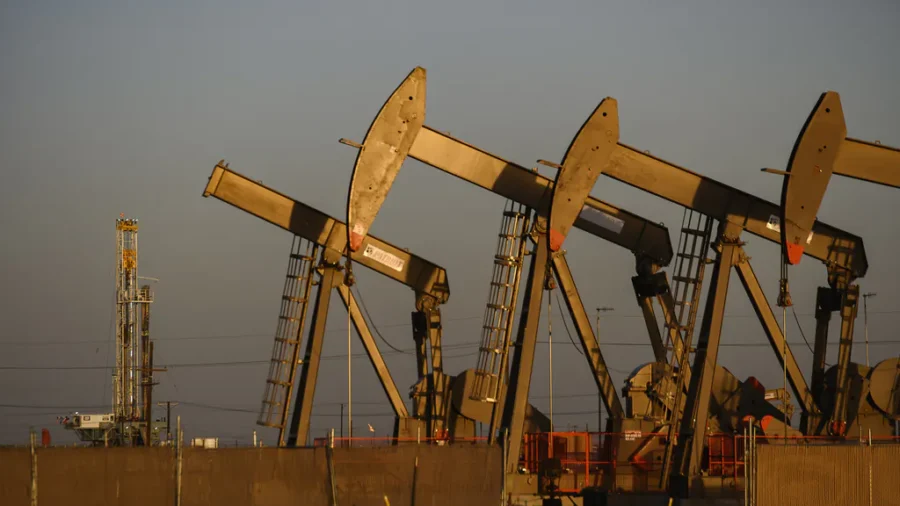President Joe Biden’s administration advanced efforts on Friday that would raise the costs for drilling for oil and gas on public lands.
The U.S. Department of the Interior and its Bureau of Land Management (BLM) announced a revised fee schedule on April 12 for its onshore federal oil and gas leasing program. The department said this updated fee schedule includes royalty rates, rental rates, and minimum bids to lease public land for drilling projects.
“These are the most significant reforms to the federal oil and gas leasing program in decades, and they will cut wasteful speculation, increase returns for the public, and protect taxpayers from being saddled with the costs of environmental cleanups,” Interior Secretary Debra Haaland said of the plan.
The rule change would mean companies seeking to buy land lease options at auction would have to bid a minimum of $10 per acre, up from $2 per acre currently. That minimum bid requirement will remain at $10 per acre until 2032, after which minimum bids for leases will be adjusted for inflation annually.
The rule also revises the costs to continue renting each acre. Companies currently pay $1.50 per acre for the first five years holding a lease, then $2 per acre for the next five years. The new plan will have companies pay $3 per acre leased for the first two years, then $5 per acre per year for the subsequent 6 years, and then $15 per acre each year after that.
Currently, companies pay a minimum of 12.5 percent royalty for the gross production value of the oil or gas extracted from leased public land. The new rule raises the minimum royalty to 16.67 percent until at least 2032, and states this 16.67 percent royalty will remain the new minimum thereafter.
The new plan also raises bond requirements for reclaiming oil and gas wells dug on public land. Until now, companies had to put up about $10,000 for reclaiming wells and cleaning up any environmental damage caused by drilling operations. Companies also had the option to put up bonds on a nationwide and per-unit basis. Now companies will have to pay a minimum of $150,000 per lease, and a minimum of $500,000 per state they operate.
“The previous lease bond amount of $10,000—established in 1960—no longer provided an adequate incentive for companies to meet their reclamation obligations, nor does it cover the potential costs to reclaim a well should this obligation not be met, leaving taxpayers at risk for the cost of cleanup,” the Interior Department said in a press statement detailing the new bond requirements.
Bond amounts will also be adjusted for inflation every 10 years going forward.
Environmentalists, Industry Members React
The Biden administration’s move to hike costs for fossil fuel extraction on public land earned praise from environmental groups on Friday.
“For decades, taxpayers have been left to foot the bill to clean up toxic messes left behind by oil companies across the West, while some of the same companies made record profits,” Earthjustice attorney Mike Freeman said in a Friday press statement. “BLM also has tolerated rampant speculation on leases that industry only purchased to pad its books and attract investors, while preventing those lands from being protected for other uses. On top of this, oil and gas drilling on public lands accelerates the climate crisis and results in oil spills and threats to drinking water. The Biden administration’s Oil and Gas Rule is an important step toward correcting these long-standing problems and holding oil and gas companies accountable.”
Athan Manuel, director of the Sierra Club’s Lands Protection Program, also welcomed the move to raise drilling costs.
“These new regulations are the kind of common-sense reforms the federal oil and gas leasing program has needed for decades,” he said. “The days of oil and gas companies locking up public lands for decades for pennies on the dollar and leaving polluted lands, water, and air in their wake are over.”
The added costs are likely to come as a blow to the domestic fossil fuel industry.
Dan Naatz, the chief operating officer and executive vice president of the Independent Petroleum Association of America (IPAA), said the increased costs won’t actually improve stewardship of federal lands, but simply drive oil and gas industry members away from certain areas.
“The regulatory environment has become so hostile to American oil and natural gas producers operating on federal land that it’s clear the Biden Administration intends for ‘multiple use’ lands to only be used for conservation and recreation,” Mr. Naatz said.
Mr. Naatz also argued the regulations will come at a steep cost to local communities sustained by the oil and gas industry.
“The true losers with this misguided policy are states and localities that rely on revenues from federal land extractive industries to meet their budget obligations year after year,” Mr. Naatz continued. “Rather than taking their mandate to be good stewards of federal land for the betterment of the American people seriously, the Biden Administration continues to ignore the people in local towns and communities across the West in order to placate a small group of environmentalists and to further reduce American oil and natural gas production.”

